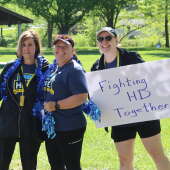In Demand: Southeast’s UAS and cybersecurity programs preparing students for tech-savvy careers

Southeast Missouri State University unmanned aircraft systems (UAS) major Brigham Haase is mapping the wetlands of Missouri using drone technology.
He calls this a “one-of-a-kind undergraduate research project” that began in Scott City, Missouri, with additional locations to follow. Haase and his fellow UAS students are paving the way for a future in the unmanned aircraft systems industry and mechatronics, where they say the sky’s the limit.
“The jobs are going to be everywhere, because drones make life easier in many ways,” he says.
The junior from Kankakee, Illinois, says he’s hoping to land an internship with Planck Aerosystems in California, and eventually work with Planck or the National Geospatial Intelligence Agency (NGA) after graduation.
Unmanned aircraft systems and cybersecurity are among the academic offerings growing in popularity at Southeast among students wishing to hone their skillsets in next-generation technologies. Today’s students are finding Southeast to be a new version of their father’s alma mater, a campus laser-focused on career preparation to meet workplace demands, with many students increasingly pursuing emerging technologies.
The curriculum at Southeast Missouri State University is evolving to train students for ever-changing and accelerating technological advancements across many industries.
“Innovation is the key to the future,” says Dr. Carlos Vargas, president of Southeast. “I would like to see students who graduate from Southeast leave this institution with the ability to innovate by developing or applying new and emerging technologies to solve real-life problems. We hope our programs propel them on that path.”
Southeast launched its UAS program last year and its cybersecurity program in 2011, with many students eager to take advantage of the new academic offerings.
UAS Program

“I chose UAS as my major because drones are becoming the leading tech in many fields” and a resource almost any field can use, says UAS major and junior Nathan McKlin of Ste. Genevieve, Missouri. “The job market in UAS is growing faster than most can keep up with. I have a hard time narrowing just one specific field that I want to focus on. Photography, movie making, surveying and agriculture are just a few of the many fields UAS majors can dive into.”
Dr. Jim Peterson, assistant professor in Southeast’s Department of Engineering and Technology, says, “Careers in technology are changing rapidly. The UAS career path is directly tied to new technology and is still in the disruptive phase. UAS technology is moving at an even faster pace than technology in general. We have to give the students a flexible set of skills that employers desire, as jobs are imagined and UAS technology evolves.”
Students are drawn to the UAS program’s mechanical and electronics “mechatronics” foundation with a choice of professional specialties. Mechatronics combines the engineering technology of both electronic and mechanical systems, training students to work with a variety of complex machines, such as UAS.
“I don’t know of any other mechatronics degrees in the United States similar to Southeast’s Bachelor of Science in UAS,” Peterson says. “This is the best curriculum for meeting the needs of a UAS company or company that uses UAS as a tool. Unless you go to work for a narrow set of companies involved in strictly aviation, our degree better prepares students for the needs of most UAS employers.”
Skills gained in the program have many applications with agriculture being an important one in Southeast Missouri. Drones are now being used for assessing the nutrient status of crops and scouting for diseases and insects in fields. Drones also are gathering accurate data about crops and improving efficiency in agriculture fields.
Andy Chronister coordinates Southeast’s Agriculture Technology Virtual Incubation program via the University’s Economic and Business Engagement Center to assist business and industry in Southeast Missouri. UAS are a critical component of his work.
Chronister recently captured Normalized Difference Vegetation Index (NDVI) images over several rice plots at the Missouri Rice Research Farm in Glennonville, Missouri, as part of a research grant while assisting Southeast’s rice breeder with his data needs.
UAS technology is here to stay, Peterson says, and how UAS are used will continue to change as laws become less restrictive or as waivers to perform tasks that currently are illegal become commonplace. With these changes, the type of job-specific training will need to quickly change.
Many agencies predict rapid growth in jobs for those trained in UAS.
“Even if half of the predictions come true,” he says, “it is a great area to be trained in and ready for whatever exciting career a student can imagine.”
Cybersecurity Program
Like UAS, the cybersecurity field is mushrooming as well, as massive data breaches continue to plague companies, putting online consumers of goods and services at enormous risk. Because security and privacy are intertwined like never before, protecting our digital assets is more important than ever.
That’s why training students to meet the workforce demand for cybersecurity professionals is critical to our future, says Dr. Vijay Anand, director of Southeast’s cybersecurity program, faculty advisor to Southeast’s cyber defense team and associate professor of computer science.
“As long as there are people with malintent, there will always be the need for skilled professionals to protect our assets,” he says. “This skillset is in high demand.”
The U.S. Department of Labor expects a 22 percent growth in job demand over the next decade in this area as security against hackers and disruption is an ongoing and growing concern. Business and agency leaders regularly express the need for highly-trained employees in cyber protection, and Southeast is working to help fill this niche.
Southeast’s cybersecurity program has swelled from 15 students in its infancy in 2011 to more than 150 students today, with 60 students completing cybersecurity degrees since the first cohort graduated from the program in spring 2014. The program is one of only four nationally to hold accreditation from the Accreditation Board for Engineering and Technology, Inc. (ABET). Graduates are meeting the growing need for security of computer networks and systems that store digital personal, financial, health and governmental records. They regularly secure employment with top-level firms, including AIG, PricewaterhouseCoopers, Dell Secureworks, Enterprise, Express Scripts, Ameren and Mandiant, and locally with Big River Telecom, Element 74, Visient and area law firms.
“Southeast has become a preferred university for recruiting among top-level companies,” Anand says.
Cybersecurity student Lucas Kossack of Grantsburg, Illinois, recently landed a job as an associate consultant with Mandiant, a FireEye Company, in the Washington, D.C./northern Virginia area after interning with the company last summer. He is a former team captain and member of Southeast’s cyber defense team which has won six-straight Missouri Collegiate Cyber Defense competitions. He plans to graduate from Southeast this month.
“Southeast gave me the building blocks that allowed me to obtain a job I enjoy doing every day at FireEye Mandiant, and it means a lot to me,” he says. “Dr. Anand, in particular, is probably one of the best mentors I could have had to prepare me for a job in cybersecurity, and I'll be forever thankful for his guidance.”
Southeast cybersecurity graduates are increasingly sought after by tech-savvy employers who rely on cyberinfrastructure for their operations. Cybersecurity graduates are needed for crucial roles in national and international industries and private and public-sector companies.
Southeast is enabling many students in the local area to earn cybersecurity degrees and enjoy lucrative careers due to the demand for cybersecurity professionals, Anand says. Yet, while graduates are finding success in the workplace, employers continue to indicate that the need for cyber-savvy employees is outpacing available graduates skilled to perform these duties.
“There is a major shortage of cybersecurity professionals or professionals who are trained in many aspects of security in cyber-enabled systems,” Anand says.
While job candidates may understand some aspects of the field, holistic training in cybersecurity has not been available until recently, he says. But for those armed with this skill set, the opportunities continue to grow.
Data insurance is among many emerging industries demanding a cyber-trained workforce.
“This is a new field that is up-and-coming,” Anand says, with consumers purchasing insurance to protect their data from hackers.
He says alumni of Southeast’s cybersecurity program already are working in the insurance sector, including with AIG.
“AIG and cybersecurity are a very unlikely mix, but it’s an important mix at this point because there are assets that are digitized, and they want to protect them,” Anand says.
In the near future, Anand envisions graduates working on smart roads, an innovation in transportation infrastructure in development in some states that will require an entirely new type of technical maintenance. A smart road incorporates technology into the highway.
“A smart road communicates with the vehicle, and the vehicle is communicating with the road,” Anand says.
Smart roads move vehicles autonomously or assist with their motion, he says. Uber and other companies are exploring how to interface with smart roads and with vehicle-to-vehicle communication, vehicle-to-road communication and vehicle-to-infrastructure communication.
“These are research ideas that are still in the lab, but they are going to come around pretty soon. Change is inevitable, and that is definitely coming,” Anand says. “When that system comes around, we will need people to maintain those roads. Our roads will not be just repaired. We will need to make sure our smart sensors on our roads function as expected. We’ve got to secure those sensors and other information that is extracted from them, so there will definitely be a demand” with this technology.
Other sectors also are in need of cybersecurity graduates. The U.S. military needs cybersecurity professionals for its security operations, as the importance of protecting the nation’s utilities continues to mount.
“If we don’t have power or we don’t have water, even for a day, our way of life is impacted,” he says. “We need security professionals to make sure that such a thing doesn’t happen.”
To that end, cybersecurity students will be able to advance their education in a new Master of Science in cybersecurity beginning in Fall 2019 at Southeast. The new program will focus on critical societal and business infrastructure — water, power, communications, military, healthcare and transportation — to meet this need.
Southeast also expects to open a new Cyber Range on the second floor of Dempster Hall next spring to provide an enhanced environment for specialized cybersecurity research, testing and training. A Cyber Range consists of servers, routers, networking equipment, monitors and an uninterrupted power supply. It is expected to serve as both a resource to students and faculty and assist in providing the infrastructure to host and promote education and training opportunities. Southeast anticipates the Cyber Range will become a catalyst for creating a centralized point for encouraging and promoting partnerships between government, industry, education and other sectors.
Anand says, “It will be an amazing resource not only for the University but also the entire region.”

































